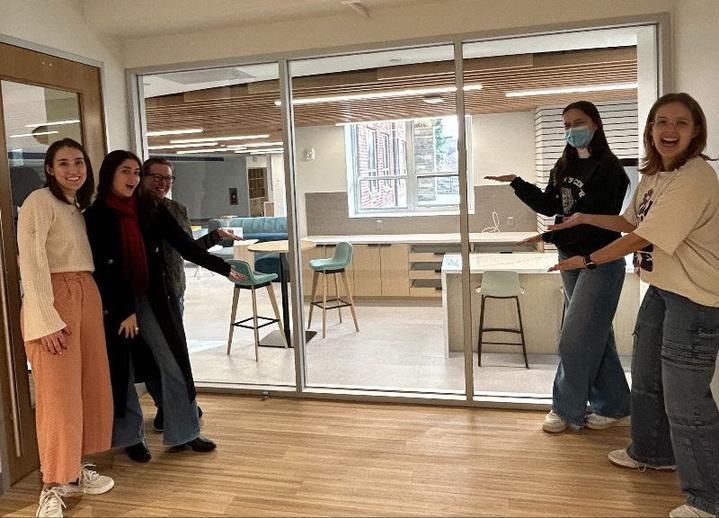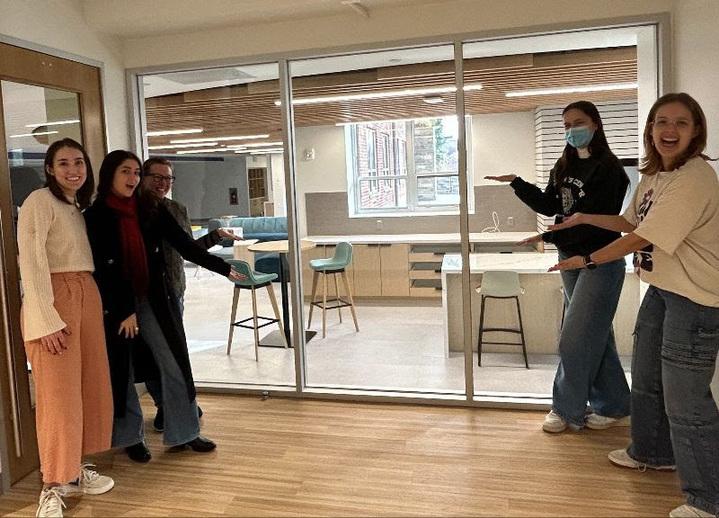Georgetown University’s Office of Student Engagement and Inclusion (OSEI) relocated to the basement of New South Hall this January, consolidating its initiatives into a new refuge on campus.
Furnished with couches, desks and study areas, the new area offers additional seating and room compared to prior center locations. OSEI comprises four resource centers that seek to foster diversity on campus: the Center for Multicultural Equity and Access (CMEA), the Women’s Center, the LGBTQ+ Center and the Disability Cultural Center, which were previously dispersed throughout the third and fifth floors of Leavey Center.
Sabrina Gomez (SFS ’27), a student intern with CMEA, which supports marginalized students at Georgetown, said that the space started undergoing renovations last fall and will officially open on Valentine’s Day.
“We want it to be a welcoming space for everyone, and each office holds different resources,” Gomez told The Hoya.
In the new space, the Women’s Center will offer support by providing free feminine products and having gender-inclusive bathrooms, according to Annie Selak, director of the Georgetown University Women’s Center.
“The Women’s Center provides free period products and pregnancy tests, but people of all genders menstruate,” Selak wrote to The Hoya. “In the new space, period products and pregnancy tests are located in the restroom, streamlining access for all students. The bathrooms are gender-inclusive, private, and accessible.”

The new space also includes a sensory room where students can read, do homework or attend therapy sessions in a quiet space. Dr. Amy Kenny, the director of the DCC, said the sensory room contains various activities and features to promote students’ well-being.
“This space features our sensory room, with interactive light technology, textured walls and various stim tools to meet people’s sensory needs,” Kenny wrote to The Hoya. “We wanted this space to be as inclusive and accessible as possible, so our students can thrive in this space.”
Zayn Bhimani (SFS ’26), another student intern at the CMEA, said OSEI’s new space is much brighter and more accessible, inviting many new people to come to the center.
“Last semester and last year, we were on the fifth floor of Leavey Center, which is kind of small and cramped,” Bhimani told The Hoya. “So it’s definitely much brighter. The main space is the best part, because there’s so many different conversations happening all the time, so there’s always people to talk to.”
Having all the branches of the OSEI together offers additional communication opportunities across branches, according to Chloe Smith (SON ’26), a student academic assistant with the DCC.
“We have had a couple of months already in collaboration with the other centers, and it’s just been a way to get to know a lot more people that I have never met,” Smith said.
Smith said her work with the DCC strives to create a diverse and inclusive space that supports the needs of students with disabilities on campus.
Georgetown is the first Catholic, Jesuit institution to have a Disability Cultural Center (DCC), which has grown from Georgetown’s Disability Cultural Initiative. The center opened in September 2023.
Smith said the DCC’s goal is to help foster a culture of access on campus and provide support to students who may have disabilities.
“The Disability Cultural Center’s goal is to create a culture of access here at Georgetown, and we offer support for students who may have disabilities, invisible or visible, as well as just the space to get to know each other and celebrate those disabilities,” Smith said.
Smith said Art Celebrating Disability Culture (ACDC), one of these support programs, encourages the celebration of disability culture through art as well as a lending library.
“We gather students from Georgetown who do paintings or poems or dance or whatever they think is art, and it’s essentially to celebrate disability culture,” Smith said. “Another thing that we have going on here is a lending library with a lot of books from disabled authors and books featuring specific disabilities so that people can learn from these authors.”
Adanna J. Johnson, the associate vice president for student equity and inclusion, said the new intersectional space is a commitment to Georgetown’s Jesuit mission of supporting all students and their success on campus.
“We need to ensure that Georgetown’s approach is truly integrated across the campus because it is central to the success of all students and is clear in our Jesuit mission and values,” Johnson wrote to The Hoya. “This new intersectional space deepens our commitment to this approach.”
Smith said that the new space addresses various needs and helps to foster a sense of community.
“For people who might have different needs, we also have a community room. And so that’s also good for holding events and there’s a kind of study space in here as well,” Smith said.















